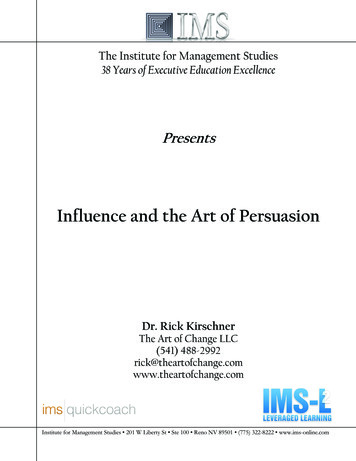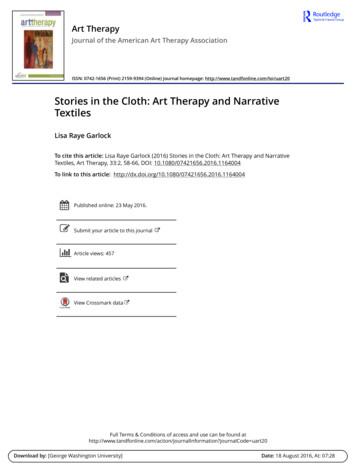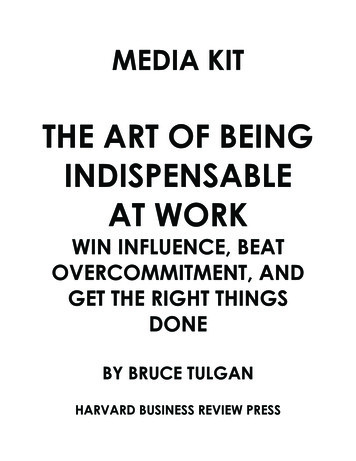
Transcription
The Institute for Management Studies38 Years of Executive Education ExcellencePresentsInfluence and the Art of PersuasionDr. Rick KirschnerThe Art of Change LLC(541) comInstitute for Management Studies 201 W Liberty St Ste 100 Reno NV 89501 (775) 322-8222 www.ims-online.com
Prepared exclusively for the Institute for Management StudiesINFLUENCE andTHE ART of PERSUASIONwith Dr. Rick KirschnerHighlights:Useful Definitions & Persuasion DynamicsListen to Go Deep/Mission: Find The MapPersuasion Signals & GuidesUncle MiltyCore Ideas in this program:“Persuasion is driven by curiosity.”“Change happens in stages.”“Confidence grows from preparation.”Material is The Art of Change LLC, All Rights Reserved.Visit TheArtOfChange.com for more information.The Art of Change LLC P.O. Box 896, Ashland, OR 97520 541.488.2992 rick@theartofchange.com
Page 1TABLE OF CONTENTSCOVERPage 1!Table of Contents: You’re reading it now!Page 2!Useful Definitions: Influence, Attitude, Persuasion, ManipulationPage 3 !Persuasion Proposition (Begin with the end in mind)Page 4!Persuasion Dynamics: Four possible outcomes, Three receiving zonesPage 5!Five Stages of ChangePage 6!Blending To Build TrustPage 7!Listening BasicsPage 8!Listening for Interpersonal Needs-StylePage 9!Listen So People Talk: Nine Information GatesPage 10!Taxi Driver: Make Your Own ExamplePage 11!Listen For PositionPage 12!Homework: Assume The PositionPage 13!Listen So People Talk: Personal MotivationsPage 14!Listen for MotivationPage 15!Stack MotivationsPage 16!Talk So People Listen: Two Ways People Hear YouPage 17!Talk So People Listen: Seven Persuasion SignalsPage 18!Talk So People Listen: Delivery Guides To Maximize ResponsivenessPage 19!Talk So People Listen: Openers and TransitionsPage 20!Uncle Milty ChecklistPage 21!Uncle Milty WorksheetPage 22!Review: Persuasion CountdownPage 23 !Internet Resources from Dr. KLast Page!About Dr. Rick Kirschner and The Art of Change Skills For Life The Art of Change LLC, All Rights Reserved Dr. Rick Kirschner drkinfo@TheArtofChange.com
Page 2USEFUL DEFINITIONSNatural Influence:Based on trust. The power to cause an effect indirectlyNegative influence:Coercion is the exercise of control to gain compliance. Loss of trust is the cost of coercion.Attitude:A person’s motivations and positions regardingthe subject at hand,Why Attitude Matters:Attitude drives behaviorThe Art of Persuasion:Deliberate attempt to influence the attitude ofothers to bring about a desired result.!Is Persuasion the same thing as Manipulation? YESBest Defense Against Manipulation: Think for yourself!NOHow To Create The Result Of Resistance:Insistence:Persuasion is not about demanding compliance.Discomfort: Your discomfort with whatyou’re saying will create a resonant discomfortin hearing it.Tell and Sell:Effective Persuasion is about caring and sharing.Resistance: If you resist change, you createpermission for resistance in others. The Art of Change LLC, All Rights Reserved Dr. Rick Kirschner drkinfo@TheArtofChange.com
Page 3PERSUASION PROPOSITION(Begin with the end in mind)Who do you want to persuade?What do you propose?Where & When will you propose it?Why do you want to persuade your persuadee (your motivation)?What does your persuadee want?Why should they care about your proposition? (persuadee’s motivation)How does your proposition help them get what they want or need? The Art of Change LLC, All Rights Reserved Dr. Rick Kirschner drkinfo@TheArtofChange.com
Page 4PERSUASION DYNAMICSParallel: No change in sender or receiverPolarized: Both move farther apartMerge: Both arrive at new understandingPersuasion: Move toward SenderParallel is the result of people listening to themselves talk.Polarized often results from people defending their positions to each other.Merge is a result of people listening, understanding, considering and agreeing.Persuasion results from finding the MAP, and delivering a compelling proposition.People place incoming information into 1 of 3 zones:Acceptance, Uncommitted, RejectionEach zone contains all the positions for that area.A person’s MAP of reality (motivations, access andpositions on a particular topic or idea) is in the Acceptance Zone.The closer you can get to their MAP (understandingit and speaking to it), the more persuasive you will be.The more developed the MAP, the more invested a person is in a particular MAP of reality, thewider the zone of rejection, and smaller the zone of acceptance (narrow mind).The less investment, the larger the zone of acceptance (open mind).This is why it is important to know everything you can about the MAP. Once you know a person’s MAP, you can find Common Ground with it, and build agreement on agreement as yourplatform, and then introduce your proposition from that platform on those agreements. The Art of Change LLC, All Rights Reserved Dr. Rick Kirschner drkinfo@TheArtofChange.com
Page 5FIVE STAGES OF CHANGEIGNORANCE:Don’t know about change, don’t know why, don’t know why it mattersRECOGNITION:Re-Cognize. See the light. Seek information about options.PLANNING:Re-Organize around the change. What needs to change? Specific actions, times, places.ACTION:Try it on, find out, learn and improve.REHEARSE:Do it until you can do it without knowing that you’re doing it.Which Stage Are You?Identify a specific change you desire to make.Which stage best describes your relationship to that change?Where are you at in the change process?What stage is next? The Art of Change LLC, All Rights Reserved Dr. Rick Kirschner drkinfo@TheArtofChange.com
Page 6GET TO COMMON GROUNDUse Blending To Build TrustPeople experiencing stress seek signals that indicate whether you’re with them or against them.There is no middle ground. The basic rule of relationship is in play: No one cooperates withanyone who seems to be against them.55%, 38%, 7%55% of the meaning people make in communication is based on what it looks like someone is saying. 38% is based on what it soundslike someone is saying. 7% is based on whatpeople are actually saying. Said another way,people decide if you’re with them or againstthem based mostly on how you look andsound when you interact with them. Whenyou send nonverbal signals of similarity, cooperation tends to increase.“I’m With You!”Blend with the 55% through body posture,animation, and facial expressions.Blend with the 38% through voice tempo andvoice volume.Blend with style: Emotional or matter offact. Brief or verbose. Direct and to thepoint, indirect and detailed, indirect and considerate, direct and enthusiastic. The Art of Change LLC, All Rights Reserved Dr. Rick Kirschner drkinfo@TheArtofChange.com
Page 7THE ART OF LISTENINGKey Idea:People are innately resourceful. Listening connects people to their resourcefulness.Five Great Reasons To Listen WellPeople want to be heard and understood.People love to hear themselves talk.People are drawn to people who listen.Most people don’t know what they are talking about unless asked.Information is power.Definitions:Surface Structure: Conscious aspects of experience. What someone thinks.Deep Structure: Subconscious aspects of experience. Where the thoughts come from.Basic Rule:Go Deep!How to listen:!!Look and sound like you completely understand (nod and grunt)Verbal Backtracking: Repeat back keywords from what the person saidThe time to look confused is when you are asking questions.Key Idea: Always backtrack before asking a questionSimplest ways to go deep:Don’t know what to ask? Say, “Tell me more.”Doesn’t make sense? Ask, “What does that have to do with this?”!!!!When to listen:When you seek to persuade. When a person is upset. When being criticized. When someone islying or has a hidden agenda. Remember, you can’t reason with an emotional person. But you canget an emotional person to become reasonable. Just listen to go deep, and help them get to what’sreally going on. The Art of Change LLC, All Rights Reserved Dr. Rick Kirschner drkinfo@TheArtofChange.com
Page 8BLEND WITH NEEDS-STYLEDr. Rick says “Meet people where they are and they are more likely to follow you.”Key Idea:Some people need their interactions to lead to action. They tend to be direct and get right to thepoint. Others are concerned with accuracy, and require more time to address the subject. Somepeople are more concerned with how you feel about the interaction than they are with the pointit. And some people need to feel important when they interact with you, and seek to hold yourattention as a result. Opportunity: You can increase your persuasiveness by blending with theircommunication style. You can determine this through attention to focus and assertiveness level.FocusEnd result or details of a taskAssertiveness or DirectnessAbout others, about selfInterpersonal NeedAction: Task focused, DirectAccuracy: Task focused, indirectApproval: People focused, indirectAppreciation: People focused, directBlend with Need-StyleAction: Direct and get to the pointAccuracy: Indirect and detailedApproval: Indirect and considerateAppreciation: Direct and enthusiastic The Art of Change LLC, All Rights Reserved Dr. Rick Kirschner drkinfo@TheArtofChange.com
Page 9DRIVING THE TAXI1. CONFUSION GATE: MISSING “W’s”All nouns are unspecifiedASK: Who, what, where, when?I’m upset.What specifically upsets you?Meet me later. Where & when shall we meet?People don’t care. Who specifically doesn’t care?2. INACTION GATE: VAGUE VOIBSAll verbs are unspecifiedQuestion: How?It fools me every time. How does it fool you?3. STUCK GATEAn active process turned into a thingQuestion: How (then unfreeze the verb)?I have a lot of frustration.How are you frustrated?Her insults hurt our relationship.How did she insult you? How did it hurt the way you relate?4. INHIBITION GATEOption stated as limitationQuestion: What would happen? What stops you?I MUST NOT.What would happen if you did?I HAVE to/SHOULD.What would happen if you didn’t?I CAN’T.What stops you?5. ABSTRACTION GATE: NEVER, ALWAYS, ALL, NOBODY, TOTALLYQuestion: Exaggerate tonally, and ask for counter-exampleI never get help when I need it. You NEVER get what you want? Wasn’t there even one time?”I totally forgot everything. You totally forgot everything? There’s not one thing you remember?6. BLAMING GATEX causes Y.Question: How specifically does X cause Y?He drives me crazy.How does he drive you crazy?Her attitude bugs me.How does her attitude bug you?7. EXCUSES GATEIf not for Y, I’d do X.Question: How does Y prevent X?I’d be in Toledo, but I lost my underwear! How does losing your underwear stop you from.?8. PROJECTION GATEClaim to know internal state of othersQuestion: How do you know?They ignore me. How do you know they ignore you?He won’t do it.How do you know he won’t do it?9. SUPERIORITY GATEPersonal rule stated as universal ruleQuestion: According to whom?Nice people smile back. According to whom?Good managers stay out of the way! Who told you that? What is that from? The Art of Change LLC, All Rights Reserved Dr. Rick Kirschner drkinfo@TheArtofChange.com
Page 10MAKE YOUR OWN EXAMPLECONFUSION GATE: MISSING “W’s”All nouns are unspecifiedASK: Who, what, where, when?INACTION GATE: VAGUE VOIBSAll verbs are unspecifiedQuestion: How?STUCK GATEAn active process turned into a thingQuestion: How (then turn the noun back into a verb)?INHIBITION GATEOption stated as limitationQuestion: What would happen? What stops you?ABSTRACTION GATE: NEVER, ALWAYS, ALL, NOBODY, TOTALLYQuestion: Ask for the missing W. If necessary, exaggerate tonally, andask for counter-exampleBLAMING GATEX causes Y.Question: How specifically does X cause Y?EXCUSES GATEIf not for Y, I’d do X.Question: How does Y prevent X?PROJECTION GATEClaim to know internal state of othersQuestion: How do you know?SUPERIORITY GATEPersonal rule stated as universal ruleQuestion: According to whom? Who told you that? The Art of Change LLC, All Rights Reserved Dr. Rick Kirschner drkinfo@TheArtofChange.com
Page 11BONUS MATERIAL: LISTEN FOR POSITIONWhat it is: A position is an assumption or opinion stated as a fact. To build a position, aperson must draw a conclusion. To bolster a position, a person must stop gathering information(“I’ve made up my mind!”) Positions, therefore, represent the end of the line of critical thoughton a particular subject or issue. Once a position is taken, mental activity is organized aroundaccumulating supportive factual and/or emotional evidence, which then become rehearsedarguments. Warning: Taking a position about a position isn’t going to help you to persuade.Remember: There’s not much point in arguing over positions. Arguments areonly rarely persuasive. Instead, tease a position apart, learn how it works, and you may find thegaps through which you can introduce new information. The real solution to dealing with positions is to use questions to do one or more of three things: 1) introduce doubt, and providejust the right amount of critical data persuasively; 2) redefine the meaning made of the data; 3)find out the interests behind positions and address those interests in new and creative ways.3 KINDS OF POSITIONSStrong Positions: Defined in stark, black and white terms.Advice: Help preserve the main position, introduce doubt about a particular aspect only.Ex: “THIS is the way to do it”Response: How does that work in this particular circumstance?Weak Positions: Surrounded by doubts.Advice: Understand the doubts and address them.Ex: “I don’t think that’s a good idea.”Response: What about it isn’t good? Here’s what we can do about that.Opposition: It’s about your position and their values.Advice: Acknowledge the value, show how a failure to support your position undermines thatsame value.Ex: That idea is wasteful.Response: What about the waste of time and money we invested in developing the idea? The Art of Change LLC, All Rights Reserved Dr. Rick Kirschner drkinfo@TheArtofChange.com
Page 12ACTIVITY: ASSUME THE POSITIONTry this on one of your own positions.1. State your position on something you care deeply about Work-related issues(wages and compensation, management-employee relations, current businessmodel) political issues (taxes, healthcare) or global issues (global warming,child hunger, nuclear nations, climate change.) Write it as a sentence.2. Apply the information gate questions to GO DEEPER into your understandingof how this position was formed and what evidence was used to support it,what evidence was ignored to bolster it.3. Consider your needs-Style4. Consider your MotivationTowards or Away? Which motivation(s) specifically?Question: What new information or counter - examples exist that might changeyour position? What haven’t you considered? What troublesome details aren’ttaken into account? What would happen if you did?Debrief: What have you discovered about assuming a position? How is that useful? The Art of Change LLC, All Rights Reserved Dr. Rick Kirschner drkinfo@TheArtofChange.com
Page 13MOTIVATION Direction of motive, ther towards (desire) or away (fear). A person’s motivations should guide what you say. There are many motivational models. This is one of them.THE KIRSCHNER MOTIVATION MODELMOTIVE!Towards/Away! !NotesVALUES! Right / Wrong ! !Values are intensely personal.REWARD!Win/Lose!Rewards can be intrinsic or extrinsic.CHALLENGE ! Success/Failure !Passion, preparation and perseveranceESTEEM ! !Worth/Worthless!To increase or gain prestige, influencePURPOSE! !Fulfillment/EmptinessThe BIG REASONS WHYOTHER!!Pleasure/Pain!The biological basis for all motivation?Key IdeasFear is the dark side of motivation. It often accompanies and clarifies motivation.Fear is a powerful short term motivator. Desire is a powerful long term motivator.In speaking to groups, the more motivational forces you employ, the more peoplein the group will connect with it, thus the more powerful your proposition. The Art of Change LLC, All Rights Reserved Dr. Rick Kirschner drkinfo@TheArtofChange.com
Page 14DISCOVER YOUR MOTIVATIONSWith a partner, explore your own reasonsfor doing what you do.What do you like about your work?Why do you like it?Why is that important to you?What don’t you like about it?Why don’t you like it?Why is that important to you? The Art of Change LLC, All Rights Reserved Dr. Rick Kirschner drkinfo@TheArtofChange.com
Page 15BUILD YOUR STACK:1. Identify something you must do in thedays and weeks ahead2. Come up with one reason why for eachtowards and each away motivation, thenstack them with strongest on the bottom.!VALUES(Right/Wrong)Desire to do rightFear to do wrong !REWARD(Gain/Lose)Desire for gainFear of loss!CHALLENGE(Success/Failure)How does taking action lead to success?How does not acting lead to failure? !ESTEEM (Worth/Worthless)How does taking action increase your worth?How does not acting decrease your worth?PURPOSE (Big Reasons for Being)How does taking action fulfill your life?How does not taking action leave you empty?!OTHER (Pleasure/Pain)How does taking action lead to pleasure?How does not taking action lead to pain?!! The Art of Change LLC, All Rights Reserved Dr. Rick Kirschner drkinfo@TheArtofChange.com
Page 16TWO WAYS PEOPLE HEAR YOUPeople listen logically or emotionally, rarelydo they do both. Logical persuadees preferfacts, statistics and details. So it is good tohave strong evidence. But it is not enoughto have the facts on your side.Emotional persuadees use mental shortcutsto conserve on the need for thought energy, and respond to information targetedto their interpersonal and individual needs,motivations, and positions.CONFIDENCE COMES FROM PREPARATIONWhen preparing your persuasion proposition, it is useful to prepare for both. Start by gatheringthe logic, facts and evidence to support your proposal, then follow through with your emotionalappeal. In this way, you’re prepared for anything.What logic, facts and evidence support your proposition?Make a brief list here:The RULES of EVIDENCEQuantity trumps QualityTwo kinds of testimony: Expert, and someone other than you! The Art of Change LLC, All Rights Reserved Dr. Rick Kirschner drkinfo@TheArtofChange.com
Page 17SEVEN PERSUASIVE SIGNALSAFFINITYWe like people who like us. We like people who are like us. We like people we want to be like.Keywords: Commonality. Charisma. Charm. Respect. Positive Associations.COMPARISONBad/worse, good/bad, great/good, old/new, side by side Comparisons increase value.RECIPROCITYIt’s all about a little give and take. Quid pro quo. I scratch your back, you scratch mine.Keywords: Free. Sacrifice. Favor. Here’s what I can do for you.CONFORMITYPeople don’t want to stick their neck out too far. There’s safety in numbers.When others are doing it, you should do it too.Keywords: Popular. Standard. Trend. Movement.AUTHORITYPerson in charge should know where we are and offer a better view ahead.Keywords: Status. Control. Experience. Testimonials. References.CONSISTENCYInterpreted as strength of character. The reason it is hard for people to change their minds.Keywords: Step by step,. Commitment. Promise. Agreement. Here’s how this relates to that.SCARCITYPeople value what is scarce.Keywords: Emphasize Demand. Highlight a limited Supply. Make it exclusive. The Art of Change LLC, All Rights Reserved Dr. Rick Kirschner drkinfo@TheArtofChange.com
Page 18EIGHT DELIVERY GUIDESDr. Rick says “Use the guides to structure and prepare your persuasion proposition.”Use the KISS PrincipleKeep it and . When you organize information, your listenersdon’t have to. Organization is more persuasive than chaos.Use Two Point ContrastTo be or not to be. This clarifies your points.Use the Rule of ThreesThis helps organize information, and focus on important details, amplifies the importance of aconcept. Makes something memorable.Use Rhetorical QuestionsWhen people hear a question and answer, the answer is more persuasive than a statement.Repeat and RestateGreat for building response potential, or to get more interest and attention. This allows forgreater comprehension and deeper consideration.Make Your Point ObviousIf there’s a point you want to make, either make it at the beginning or at the end of a story,metaphor or analogy.Give DirectionDirection persuades because it offers an alternative to fight or flight.Draw conclusions for your listeners and then tell them what you want them to do.Use Vivid LanguageExamples are word pictures that amplify the meaning of statistics, and also work well on theirown. Dialog works better than reporting. See-hear-feel words to add spice.“Be sincere. Be brief. Be seated.” -Eleanor Roosevelt The Art of Change LLC, All Rights Reserved Dr. Rick Kirschner drkinfo@TheArtofChange.com
Page 19TRANSITION: Build a bridge from listening to talking:!Repeat back what you’ve learned and ask, “Have I understood you?”OPENER: Something that provokes thought!Ask for a YES To The Problem!Shocking statistic!!Interesting Short Story or Metaphor!Relevant Quote or Aphorism!Historical PerspectiveWhen preparing your persuasion proposition, come up with one opener for each type. Withthe first words you speak, you can reach out to your listener(s) and grab as much attention aspossible for your proposal.1 Essential Belief: Believe in yourself.Because if you can’t convince yourself, you are unlikely to persuade others. The Art of Change LLC, All Rights Reserved Dr. Rick Kirschner drkinfo@TheArtofChange.com
Page 20UNCLE MILTY CHECKLISTMilty’s Motivation (pick one)Values / Rewards / Challenge / Esteem / Purpose / OtherMilty’s Position(s)Opinions and beliefs about the product/service/situation. Strong / Weak / Opposition?Use the Cues (pick up to three)Affinity / Comparison / Reciprocity / Conformity /Authority / Consistency / ScarcityUse the Guides (pick up to three)KISS / 2 Point Contrast / Rule of 3s / Rhetorical Questions/ Repeat and Restate /Obvious Point / Give Direction / Vivid LanguageOpener (Pick One)Suggestions: Thought Provoking Statement / Ask for a YES-To-The-Problem / Short Story/ Relevant Quote or Aphorism / Hopeful or Terrifying Comparison /Historical Perspective / Shocking StatisticsRehearsal: (Write your first draft, then practice) The Art of Change LLC, All Rights Reserved Dr. Rick Kirschner drkinfo@TheArtofChange.com
Page 21PERSUASION PROPOSITIONUNCLE MILTY WORKSHEETWho do you want to persuade? (Uncle Milty)What do you propose? (That he stay on)Where & When will you propose it? (During our session)Why do you want to persuade your persuadee (your motivation)?What does your persuadee want? (persuadee’s motivation)How does your proposition help Milty get what he wants?How will you propose it? (UNCLE MILTY CHECKLIST) The Art of Change LLC, All Rights Reserved Dr. Rick Kirschner drkinfo@TheArtofChange.com
Page 22PERSUASION COUNTDOWNREVIEW YOUR LEARNINGS:9 Information GatesWhen the gate opens, the right question takes you through8 Presentation GuidesTo make ideas and information more persuasive7 Persuasion CuesEncoded signals that increase the likelihood of being persuaded6 Motivations for ChangeReasons why people care, become involved, and change5 Stages of ChangeGo stage by stage to get more persuasion4 Possible OutcomesTwo of these are more useful than the others3 Receiving ZonesInformation flows immediately into one of them2 Ways to ListenWhy logic, facts and evidence are insufficient1 Essential BeliefWithout which none of this can work The Art of Change LLC, All Rights Reserved Dr. Rick Kirschner drkinfo@TheArtofChange.com
Page 23INTERNET RESOURCES FROM DR. KIRSCHNER:Visit TheArtOfChange.com for information on the following servicesKeynotes & TrainingTeleseminarsCoachingBooks, MP3sFree ENEWSFree 14 lesson mini-courseFresh posts every weekLearnToPersuade.comDrKBlog.comCURRENT BOOKS, EBOOKS & AUDIO IN BLOGSTORE1. Insider’s Guidebook To The Art Of Persuasion (book & ebook)Use Your Influence To Change Your World2. Insider’s Playbook To The Art Of Persuasion (book & ebook)Activities and Drills To Develop Your Skills3. Insider’s Guide To The Art of Persuasion(audio program)as MP3 Download4. GOLD PACKAGE - MP3 download PLUS both ebooksOTHER BOOKS AVAILABLE THROUGH AMAZON.COM1. Dealing With People You Can’t Stand:How To Bring Out The Best in People At Their Worst2. Life By Design: Making Wise Choices In A Mixed Up World3. Love Thy Customer4. How To Click With People: The Secret to Better Relationships The Art of Change LLC, All Rights Reserved Dr. Rick Kirschner drkinfo@TheArtofChange.com
D R . R I C K K I R S C H N E R , B E S T S E L L I N G AU T H O R ,DY NA M I C P R E S E N T E RDr. Rick Kirschner offers a powerful approach to dealing withchange that unlocks creativity, enhances team communicationand increases commitment. He creates his programs using apalette of attitudes, behaviors and skills that anyone can learnand employ. In keynote speeches for association events andconferences, in seminars and training for Fortune 1000 companies, and at executive retreats, he helps his audience find themotivation to do the important work today for creating a better tomorrow.“His presentation set the stage for the finest management retreat in our history.”-Jean Haskell, Emanuel Medical CenterDr. Kirschner is a best selling author and coauthor of numerous books and multimedia programs, including the international bestseller, ‘Dealing With People You Can’t Stand: How To BringOut The Best In People At Their Worst , ‘Love Thy Customer,’ ‘Life By Design,’ and ‘Insider’sGuide To The Art of Persuasion.‘ His new book, ‘How To Click With People: The Secret To Better Relationships In Business And In Life,‘ is in bookstores now. Rick is a faculty member of theInstitute for Management Studies, and thought leader with both Athena Interactive and CanDoGo Learning System. He is an adjunct professor of communication at Southwest College ofNaturopathic Medicine.“His keynote was so successful and well-received that the following breakout sessionwas standing room only and could barely contain the overflow crowd.”-Jill McClelland, ORPADr. Kirschner has delivered his expertise along with healthy doses of people-friendly humor andauthentic insights in thousands of radio and television appearances, interviews, newspaper andmagazine articles, from CNBC and CBC to FOX, the Wall Street Journal, USA Today, Entrepreneur, Selling Power and Success Magazine.
THE ART of PERSUASION with Dr. Rick Kirschner Highlights: Useful Definitions & Persuasion Dynamics Listen to Go Deep/Mission: Find !e Map Persuasion Signals & Guides Uncle Milty Core Ideas in this program: “Persuasion is driven by curiosity.” “Chang











